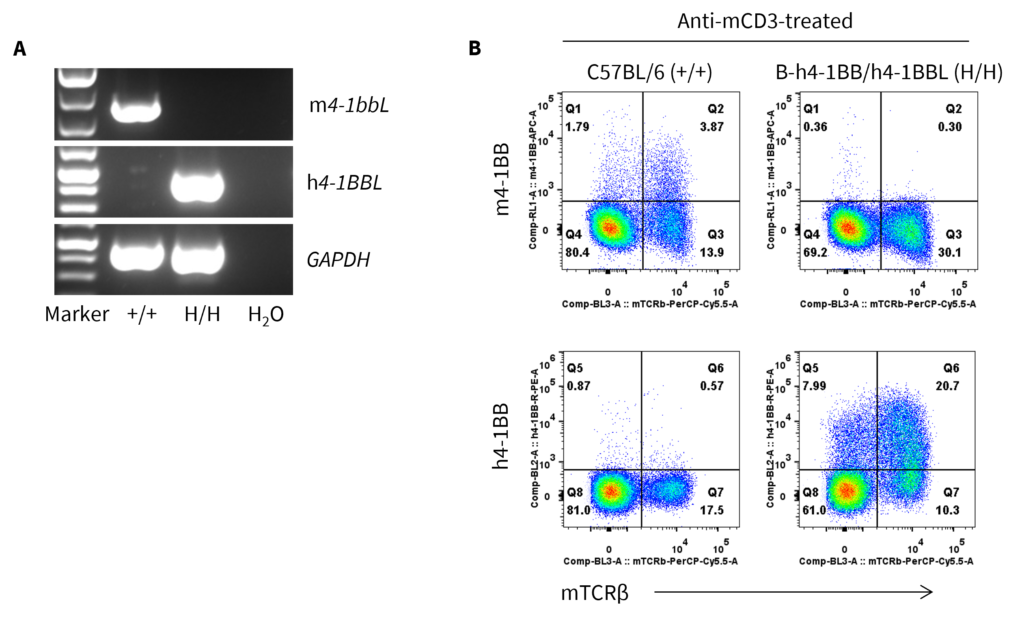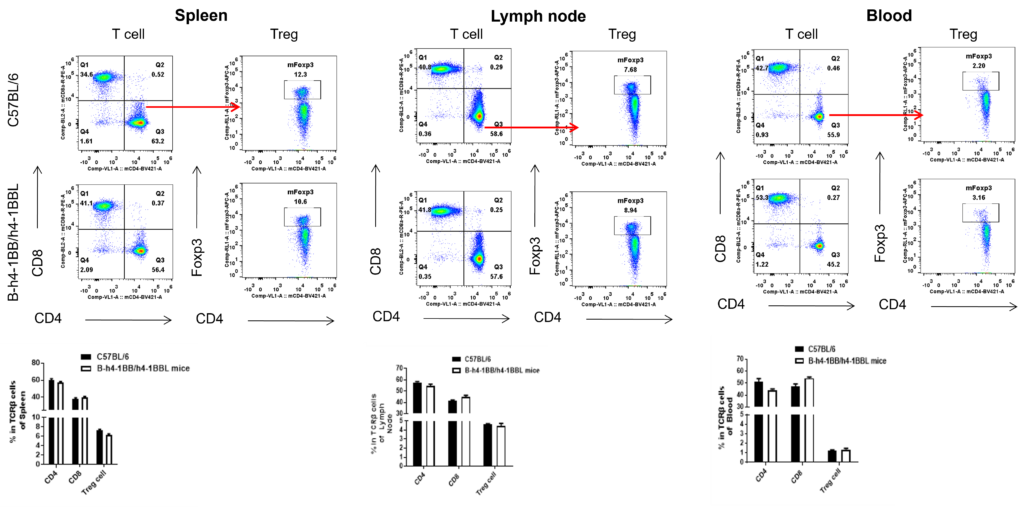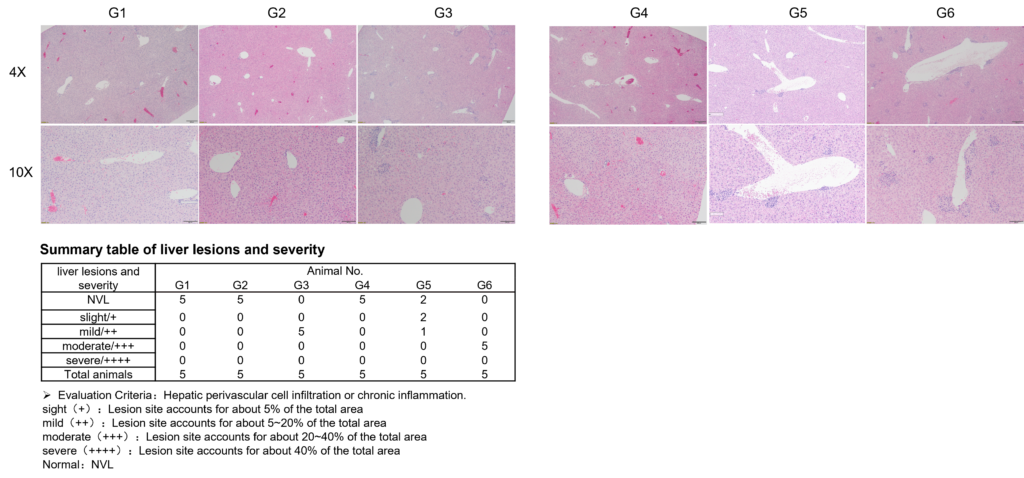Basic Information
-
Targeting Strategy

-
Gene targeting strategy for B-h4-1BB/h4-1BBL mice. The exons 2-7 of mouse 4-1bb gene that encode the extracellular domain were replaced by human 4-1BB exons 2-7 in B-h4-1BB/h4-1BBL mice. The exons 1-3 of mouse 4-1bbL gene that encode the transmembrane domain and extracellular domain were replaced by human 4-1BBL exons 1-3 in B-h4-1BB/h4-1BBL mice.
-
mRNA and Protein Expression Analysis

-

Strain specific analysis of 4-1BB and 4-1BBL gene expression in B-h4-1BB/h4-1BBL mice by RT-PCR and FACS. (A) Mouse 4-1BBL mRNA was detectable in splenocytes of wild-type mice (+/+). Human 4-1BBL mRNA was only detectable in splenocytes of B-h4-1BB/h4-1BBL mice (H/H) but not in wild-type C57BL/6 mice. (B) Mouse 4-1BB was detectable in T cells from splenocytes of wild-type mice. Human 4-1BB was detectable in T cells from splenocytes of B-h4-1BB/h4-1BBL mice.
-
Immune Cell Analysis in B-h4-1BB/h4-1BBL Mice

-

Analysis of leukocytes subpopulation in spleen. Splenocytes were isolated from C57BL/6 and B-h4-1BB/h4-1BBL mice (n=3). The proportion of leukocytes subpopulation was tested by flow cytometry. The expression profile of the leukocyte subpopulation in homozygous B-h4-1BB/h4-1BBL mice were similar to that in the C57BL/6 mice, indicating that differentiation of T, B, NK, Monocyte, DC and macrophage cells were not affected by the humanization of B-h4-1BB/h4-1BBL mice. The same results were observed in lymph node and blood.

Analysis of T cell subpopulation in spleen, lymph node, blood. Lymphocytes were isolated from spleen, lymph node, and blood in C57BL/6 and B-h4-1BB/h4-1BBL mice (n=3). These T cell subpopulations were tested by flow cytometry. There were no differences between wild-type and B-h4-1BB/h4-1BBL mice.
-
Liver Toxicity Tests

-

High-dose of human 4-1BB antibody Urelumab caused liver toxicity in B-h4-1BB mice and B-h4-1BB/h4-1BBL mice. Homozygous B-h4-1BB mice and B-h4-1BB/h4-1BBL mice were treated with PBS or Urelumab (in house) as indicated on the graph (n=5, female, 7-week-old). Serum was collected and ALT and AST levels measured on day 21. Urelumab at 20 mg/kg caused significant increase of ALT compared with PBS control in B-h4-1BB mice, while the same treatment had no effect in B-h4-1BB/h4-1BBL mice. On the contrary, there was no significant increase of AST compared with PBS control in B-h4-1BB mice, but 20ug/mL Urelumab treatment caused a significant increase of AST in B-h4-1BB/h4-1BBL mice. There was no significant change in ALT and AST in the 1mg/kg dose group both in B-h4-1BB mice and B-h4-1BB/h4-1BBL mice. Values are expressed as mean ± SEM.

In B-h4-1BB Mice (G1-G3), no obvious abnormal changes were observed in the liver when the Urelumab dose was 1mg/kg (G2). At a dose of 20 mg/kg (G3) changes were observed in 5/5 of the animals, manifested as perivascular cell infiltration or chronic inflammation in the liver, with mild lesions. In B-h4-1BB/h4-1BBL mice (G4-G6), 1 mg/kg group(G5) 3/5 of mice show pathological changes(slight 2/5, mild 1/5), but in 20 mg/kg dose (G6), all of the experimental animals could see moderate changes in liver (5/5) . Overall, the degree and incidence of liver lesions in the 20 mg/kg group (G6) were significantly higher than that in the 1 mg/kg group (G5). The results suggested that Urelumab at 20 mg/kg was more likely to perivascular cell infiltration or chronic inflammation in the liver than that at 1 mg/kg. B-h4-1BB/h4-1BBL mice were more sensitive to Urelumab toxicity effects than B-h4-1BB mice.
-
In vivo Efficacy of Anti-Human 4-1BB Antibodies

-

Anti-tumor activity of anti-human 4-1BB antibodies in B-h4-1BB/h4-1BBL mice. Murine colon cancer MC38 cells were subcutaneously implanted into homozygous B-h4-1BB/h4-1BBL mice (female, 6-7 week-old, n=5). (A) Anti-human 4-1BB antibodies Urelumab (in house) inhibited MC38 tumor growth in B-h4-1BB/h4-1BBL mice. (B) Body weight changes during treatment. As shown in panel A, anti-human 4-1BB antibodies were efficacious in controlling tumor growth in B-h4-1BB/h4-1BBL mice, demonstrating that the B-h4-1BB/h4-1BBL mice provide a powerful preclinical model for in vivo evaluation of anti-human 4-1BB antibodies. Values are expressed as mean ± SEM.
-
References

-
1.Cheng, Lian-sheng, et al. “A humanized 4-1BB-targeting agonistic antibody exerts potent antitumor activity in colorectal cancer without systemic toxicity.” (2022).


